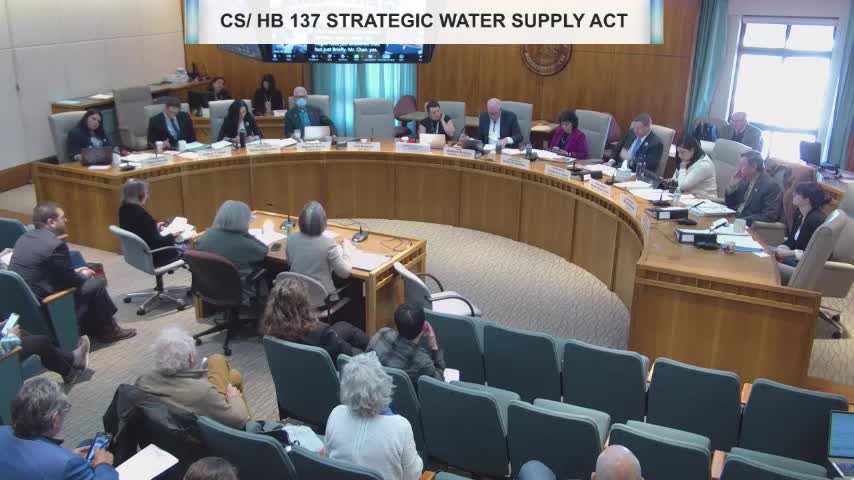New Mexico Environment Department Unveils Brackish Water Treatment Contract Guidelines
February 22, 2025 | Energy, Environment & Natural Resources, House of Representatives, Committees, Legislative, New Mexico
This article was created by AI summarizing key points discussed. AI makes mistakes, so for full details and context, please refer to the video of the full meeting. Please report any errors so we can fix them. Report an error »

In a pivotal meeting held on February 22, 2025, the New Mexico Legislature's House Committee on Energy, Environment, and Natural Resources delved into the complexities of water resource management, particularly focusing on the strategic use of brackish water. The discussions highlighted the state's approach to addressing water shortages through innovative contracts and grants aimed at enhancing water treatment technologies.
As representatives gathered under the bright lights of the legislative chamber, the conversation centered around the proposed contracts designed to support brackish water treatment projects. A key point raised was the dual nature of funding—grants versus contracts—and how each serves distinct purposes in advancing state goals. One representative sought clarity on the specifics of these contracts, questioning how they differ from traditional grants. The response outlined a vision where contracts would not only facilitate the treatment of brackish water but also ensure alignment with broader state objectives, including economic development and environmental sustainability.
The Environment Department and the Office of the State Engineer were identified as the primary agencies authorized to enter into these contracts. They would issue Requests for Proposals (RFPs) to engage treatment companies, ensuring that the projects align with local and tribal economic development goals. The contracts would require a community benefit plan, mandating engagement with local stakeholders to ensure that the projects meet community needs and preserve freshwater resources.
Concerns were raised about the vagueness of public input opportunities in the contracting process. While tribal consultation is mandated, the extent of general public involvement remains unclear. Representatives discussed the importance of transparency and community engagement, emphasizing that local governments would hold meetings to discuss contracts, thereby providing a platform for public input.
The meeting also touched on the role of the State Investment Council in connecting investments in brackish water treatment with broader economic development initiatives. This integration aims to foster innovation and support local startups, ensuring that the benefits of state investments are maximized.
As the session concluded, the representatives acknowledged the intricate balance between advancing state water management goals and ensuring community involvement. The discussions underscored the urgency of addressing water security in New Mexico, setting the stage for future initiatives that could reshape the state's approach to water resource management. The implications of these contracts and grants could significantly impact both the environment and local economies, making the outcomes of this legislative effort crucial for New Mexico's future.
As representatives gathered under the bright lights of the legislative chamber, the conversation centered around the proposed contracts designed to support brackish water treatment projects. A key point raised was the dual nature of funding—grants versus contracts—and how each serves distinct purposes in advancing state goals. One representative sought clarity on the specifics of these contracts, questioning how they differ from traditional grants. The response outlined a vision where contracts would not only facilitate the treatment of brackish water but also ensure alignment with broader state objectives, including economic development and environmental sustainability.
The Environment Department and the Office of the State Engineer were identified as the primary agencies authorized to enter into these contracts. They would issue Requests for Proposals (RFPs) to engage treatment companies, ensuring that the projects align with local and tribal economic development goals. The contracts would require a community benefit plan, mandating engagement with local stakeholders to ensure that the projects meet community needs and preserve freshwater resources.
Concerns were raised about the vagueness of public input opportunities in the contracting process. While tribal consultation is mandated, the extent of general public involvement remains unclear. Representatives discussed the importance of transparency and community engagement, emphasizing that local governments would hold meetings to discuss contracts, thereby providing a platform for public input.
The meeting also touched on the role of the State Investment Council in connecting investments in brackish water treatment with broader economic development initiatives. This integration aims to foster innovation and support local startups, ensuring that the benefits of state investments are maximized.
As the session concluded, the representatives acknowledged the intricate balance between advancing state water management goals and ensuring community involvement. The discussions underscored the urgency of addressing water security in New Mexico, setting the stage for future initiatives that could reshape the state's approach to water resource management. The implications of these contracts and grants could significantly impact both the environment and local economies, making the outcomes of this legislative effort crucial for New Mexico's future.
View full meeting
This article is based on a recent meeting—watch the full video and explore the complete transcript for deeper insights into the discussion.
View full meeting
